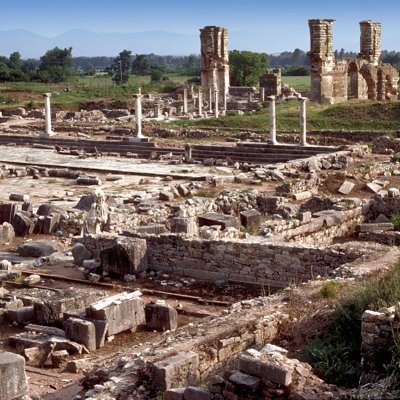
Like us on Facebook
PLACE NAMES


 
|
|
Lystra
|

|
|

The site of Lystra is believed to be located 30 kilometres (19 mi) south of the city of Konya (Iconium in the New Testament), north of the village of Hatunsaray and some 15 kilometres (9.3 mi) north of a small town called Akoren. A small museum within the village of Hatunsaray displays artifacts from ancient Lystra.
Lystra is the ancient name of the village visited by Paul the Apostle. There is a present-day village called "Kilistra" near Gökyurt, a village of the Meram district of Konya province. Ancient ruins can be seen near Klistra, including a church with a big cross marked on the wall, a winery, house-like buildings, and the ruins of a city located over the top of a hill which is locally called "Alusumas", where another church ruin can be seen. According to local people, the less-visible city was constructed over the hill to hide from enemies of ancient Anatolia. This site is still awaiting excavation.
Lystra is located on an ancient road which ran from Ephesus to Sardis to Antioch in Pisidia to Iconium and Lystra, to Derbe, through the Cilician Gates, to Tarsus, to Antioch in Syria, and then to points east and south.
It was to Lystra in the Roman province of Galatia that the apostle Paul and Barnabas came after being forced to leave Iconium because of an attempt to have them stoned. The city was then a Roman colony, having earlier been made such by Augustus. The native inhabitants, however, continued to speak the Lycaonian language. After Paul healed a man lame from birth, the crowds concluded that he and Barnabas were incarnated gods, Hermes and Zeus. Barely were they able to restrain the people from sacrificing to them. Later, however, Jews from Iconium and Pisidian Antioch so stirred up the inhabitants of Lystra against Paul that they stoned him and dragged his body outside the city, imagining him to be dead. Afterward, when surrounded by fellow Christians, Paul got up, entered Lystra, and then, accompanied by Barnabas, left the next day for Derbe.
Subsequent to their activity at Derbe, Paul and Barnabas returned to Lystra, Iconium, and Antioch. They strengthened and encouraged the disciples associated with the newly established Christian congregations in those cities and appointed older men.
Later, after the circumcision issue was settled by the apostles and older men of the Jerusalem congregation (c. 49 C.E.), Paul again visited Derbe and Lystra. The reference to this at Acts 16:1 could be understood to mean that the young man Timothy resided at either Lystra or nearby Derbe. But the evidence seems to favor Lystra. For while Derbe is not mentioned again in connection with Timothy, Acts 16:2 specifically states that Timothy "was well reported on by the brothers in Lystra and Iconium." Timothy had made such good progress that Paul chose him as a traveling companion.
When the apostle Paul visited various places in "the country of Galatia" on his third missionary tour, he may also have stopped at Lystra.
|
 Feel free to Email me any additions or corrections Feel free to Email me any additions or corrections
LINKS AVAILABLE TO YOUR SITE
| |





